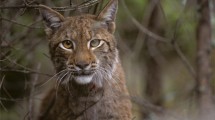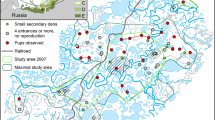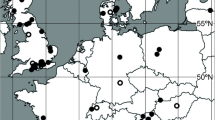Abstract
The Eurasian lynx (Lynx lynx) is a common predator of both roe deer (Capreolus capreolus) and reindeer (Rangifer tarandus) in Sweden. We investigated the influence of prey availability, latitude, sex, and age on body size and body mass variation of the Eurasian lynx in Sweden, using data from 243 specimens whose locality of capture, year of capture, sex, and age were known. We found that both body size and body mass of the lynx in Sweden are mainly affected by the lynx sex and age but also by the availability of prey during the first year of life. Body size and body mass of lynx as well as the density of roe deer increased from Central Sweden to South. Furthermore, body size and body mass of lynx increased from Central Sweden to North (i.e. within the reindeer husbandry area). Lynx body size was slightly smaller within the reindeer husbandry area (approximately north of latitudes 62°–63°N) compared to outside, probably because reindeer are more difficult prey to hunt, as well as being migratory and thus an unpredictable prey for the Eurasian lynx compared to the non-migratory roe deer. Our results support a growing body of evidence showing that food availability at growth has a major effect on body size of animals.





Similar content being viewed by others
References
Aanes R, Linnell JDC, Perzanowski K, Karlsen J, Odden J (1998) Roe deer as prey. In: Andersen R, Duncan P, Linnell JDC (eds) The European Roe deer: the biology of success. Scandinavian University Press, Norway, pp 139–160
Albon SD, Guinness FE, Clutton-Brock TH (1983) The influence of climatic variation on the birth weights of red deer (Cervus elaphus). J Zool 200:295–298
Albon SD, Clutton-Brock TH, Guinness FE (1987) Early development and population dynamics in red deer. II. Density-independent effects of cohort variation. J Anim Ecol 56:69–81
Andrén H, Liberg O (2008) Report from the lynx project. Grimsö Wildlife Research Station, Department of Conservation Biology, Swedish University of Agricultural Sciences. Report
Andrén H, Linnell JDC, Liberg O, Ahlqvist P, Andersen R, Danell A, Franzén R, Kvam T, Odden J, Segerström P (2002) Estimating total lynx (Lynx lynx) population size from censuses of family groups. Wildl Biol 8:299–306
Bolton BL, Newsome AE, Merchant J (1982) Reproduction in the agile wallaby, Macropus agilis (Gould) in the tropical lowlands of the Northern territory: opportunism in a seasonal environment. Austral J Ecol 7:261–277
Both C (1998) Experimental evidence for density dependence of reproduction of great tits. J Anim Ecol 67:667–674
Burnham KP, Anderson DR (2002) Model selection and multi-model inference, 2nd edn. Springer, New York
Clutton-Brock TH (1991) The evolution of parental care. Princeton University Press, Princeton
Clutton-Brock TH, Albon SD, Guinness FE (1987) Reproductive success in male and female red deer. In: Clutton-Brock TH (ed) Reproductive success. University of Chicago Press, Chicago, pp 325–343
Creighton GK (1980) Static allometry of mammalian teeth and the correlation of tooth size and body size in contemporary mammals. J Zool Lond 191:435–443
Danell AC, Andrén H, Segerström P, Franzén R (2006) Space use by Eurasian lynx in relation to reindeer migration. Can J Zool 84:546–555
Dooney JM, Gunn RG (1981) Nutritional and other factors in breeding performance of ewes. In: Gilmore D, Cook B (eds) Environmental factors in mammal reproduction. Macmillan, London, pp 169–177
Fowler CW (1987) A review of density dependence in populations of large mammals. Curr Mammal 1:401–441
Gaillard JM, Boutin JM, Delorme D, Van Laer G, Duncan P, Lebreton JD (1997) Early survival in roe deer: causes and consequences of cohort variation in two contrasted populations. Oecologia 112:502–513
Gaillard JM, Festa-Bianchet M, Delorme D, Jorgenson J (2000) Body mass and individual fitness in female ungulates: bigger is not always better. Proc R Soc Lond B 267:471–477
Gaillard JM, Loison A, Toïgo C, Delorme D, Van Laere G (2003) Cohort effects and deer population dynamics. Ecoscience 10:312–320
Galatti U (1992) Population biology of the frog Leptodactylus pentadactylus in a central Amazonian rainforest. J Herpetol 26:23–31
Geist V (1987) Bergmann’s rule is invalid. Can J Zool 65:1035−1038
Grøten V, Sæther BE, Engen S, Solberg EJ, Linnell JDC, Andersen R, Brøseth H, Lund E (2005) Climate causes large-scale spatial synchrony in population fluctuations of a temperate herbivore. Ecology 86:1472–1482
Haglund B (1966) De stora rovdjurens vintervanor [Winter habits of large carnivores]. Viltrevy 4:1–311 (In Swedish)
Henry CJK, Ulijaszek SJ (1996) Long-term consequences of early environment. Cambridge University Press, Cambridge
Hewison AJM (1996) Variation in the fecundity of roe deer in Britain: effects of age and body weight. Acta Theriol 41:187–198
Hewison AJM, Gaillard JM, Angibault JM, Van Laere G, Vincent JP (2002) The influence of density on post-weaning growth in roe deer (Capreolus capreolus) fawns. J Zool 257:303–309
Ihaka R, Gentleman R (1996) R: a language for data analysis and graphics. J Comput Graph Stat 5:299–414
Jędrzejewski W, Jędrzejewska B (1998) Predation in Vertebrate communities: the Biealowieźa primevial forest as a case study. Ecological studies, vol 135. Springer, Berlin
Johnson JB, Omland KS (2004) Model selection in ecology and evolution. Trends Ecol Evol 19:101–108
Johnston DR (1991) Measurement of weasel body size. Can J Zool 69:2277–2279
Jönsson KI (1997) Capital and income breeding as alternative tactics of resource use in reproduction. Oikos 78:57–66
Jorgensen T (1992) Long-term changes in growth of Northeast Arctic cod (Gadus morhua) and some environmental influences. ICES J Mar Sci 49:263–277
King CM (1989) The advantages and disadvantages of small size to weasels, Mustela species. In: Gittleman JL (ed) Carnivore behaviour ecology and evolution. Cornell University Press, Ithaca, New York, pp 302–334
Larsson K, Forslund P (1991) Environmental induced morphological variation in the barnacle goose, Branta leucopis. J Environ Biol 4:619–636
Lepage D, Gauthier G, Reed A (1998) Seasonal variation in growth of greater snow goose goslings: the role of food supply. Oecologia 114:226–235
Liberg O, Andrén H (2006) The lynx population in Sweden 1994-2004. An evaluation of the census data and methods. Grimsö Wildlife Research Station, Department of Conservation Biology, Swedish University of Agricultural Sciences. Report
Lindström J (1999) Early development and fitness in birds and mammals. Trends Ecol Evol 14:343–348
Madsen T, Shine R (2000) Silver spoons and snake body sizes: prey availability early in life influences long-term growth rates of free-ranging python. J Anim Ecol 69:952–958
Matson GM (1981) Workbook for cementum analysis. Matson Laboratory, Montana
Matyushkin YEN, Vaisfeld MA (2003) The lynx. Regional features of ecology, use and protection. Game animals of Russia and adjacent countries and their environment. Nauka, Moscow. ISBN 5-02-002789-8
Moors PJ (1980) Sexual dimorphism in the body size of mustelids (Carnivora): the roles of food habits and breeding systems. Oikos 34:147–158
Mysterud A, Østbye E (2006) Effect of climate and density on individual and population growth of roe deer Capreolus capreolus at northern latitudes: the Lier valley, Norway. Wildl Biol 12:321–329
Mysterud A, Langvatn R, Yoccoz NG, Stenseth NC (2001a) Plant phenology, migration and geographic variation in body weight of large herbivore: the effect of a variable topography. J Anim Ecol 70:915–923
Mysterud A, Yoccoz NG, Stenseth NC, Langvatn R (2001b) Effects of age, sex and density on body weight of Norwegian red deer: evidence of density-dependence senescense. Proc R Soc Lond B 268:911–918
Nilsen EB, Linnell JDC, Odden J, Andersen R (2009) Climate, season, and social status modulate the functional response of an efficient stalking predator: the Eurasian lynx. J Anim Ecol 78:741–751
O’Donoghue BoutinS, Krebs CJ, Hofer EJ (1997) Numerical responses of coyotes and lynx to the snowshoe hare cycle. Oikos 80:150–162
Odden J, Linnell JDC, Moa PF, Herfindal I, Kvam T, Andersen R (2002) Lynx depredation on domestic sheep in Norway. J Wildl Manage 66:98–105
Pedersen VA, Linnell JDC, Andersen R, Andrén H, Lindén M, Segerström P (1999) Winter lynx Lynx lynx predation on semi-domestic reindeer Rangifer tarandus in northern Sweden. Wildl Biol 5:203–211
Pettorelli N, Gaillard JM, Van Laer G, Duncan P, Kjellander P, Liberg O, Delorme D, Maillard D (2002) Density at birth and habitat quality affects adult body mass in roe deer. Proc R Soc Lond B 269:747–753
Rose KE, Clutton-Brock TH, Guinness FE (1998) Cohort variation in male survival and lifetime breeding success in red deer. J Anim Ecol 67:979–986
Skogland T (1983) The effects of density dependent resource limitation on size of wild reindeer. Oecologia 60:156–168
Skogland T (1990) Density dependence in a fluctuating wild reindeer herd: maternal vs. offspring effects. Oecologia 84:442–450
Slough BG, Mowat G (1996) Lynx population dynamics in an untrapped refugium. J Wildl Manage 60:946–961
Stearns SC (1992) The evolution of life histories. Oxford University Press, Oxford
Ulijaszek SJ, Jonhston FE, Preece MA (1998) Human growth and development. Cambridge University Press, Cambridge
Wilkin TA, Garant D, Gosler AG, Sheldon BC (2006) Density effects on life-history traits in a wild population of the great tit Parus major: analyses of long-term data with GIS techniques. J Anim Ecol 75:604–615
Yom-Tov Y, Heggberget TM, Wiig O, Yom-Tov S (2006) Body size changes in the Norwegian otter: the possible effects of food availability and global warming. Oecologia 150:155–160
Yom-Tov Y, Yom-Tov S, MacDonald D, Yom-Tov E (2007) Population cycles and changes in body size of the lynx in Alaska. Oecologia 152:239–244
Zannèse A, Baïsse A, Gaillard J-M, Hewison AJM, Saint-Hilaire K, Toïgo C, Van Laere G, Morellet N (2006) Hind foot length: an indicator for monitoring roe deer populations at a landscape scale. Wildl Soc Bull 34:351–358
Zedrosser A, Dahle B, Swenson JE (2006) Female body size in brown bears. J Mammal 67:510–519
Acknowledgments
We thank Olavi Grönwall for his warm hospitality to YYT and SYT during their visit to the NRM and to Per Ericson for his valuable support. Special thanks to Arne Söderberg at The National Veterinary Institute in Uppsala, Sweden, for his work involving age determination and biometrics of the material. We are grateful to Eli Geffen and two anonymous reviewers for valuable advice and comments and to Naomi Paz for editing the paper. We acknowledge the financial support of a SYNTHESYS grant to YYT (SE-TAF-1844. made available by the European Community—Research Infrastructure Action under the FP6 Structuring the European Research Area Programme, and the Israel Cohen Chair of Environmental Zoology to YYT. PK and HA were financially supported by the Swedish Environmental Protection Agency.
Author information
Authors and Affiliations
Corresponding author
Rights and permissions
About this article
Cite this article
Yom-Tov, Y., Kjellander, P., Yom-Tov, S. et al. Body size in the Eurasian lynx in Sweden: dependence on prey availability. Polar Biol 33, 505–513 (2010). https://doi.org/10.1007/s00300-009-0728-9
Received:
Revised:
Accepted:
Published:
Issue Date:
DOI: https://doi.org/10.1007/s00300-009-0728-9




